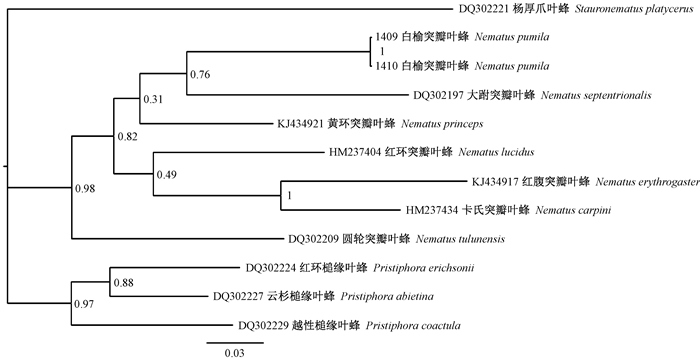文章信息
- 刘萌萌, 李泽建, 唐也, 魏美才.
- Liu Mengmeng, Li Zejian, Tang Ye, Wei Meicai.
- 危害白榆的中国突瓣叶蜂属(膜翅目:叶蜂科)一新种
- A New Species of Nematus Panzer (Hymenoptera, Tenthredinidae), a Defoliator of Ulmus pumila in China
- 林业科学, 2019, 55(6): 74-80.
- Scientia Silvae Sinicae, 2019, 55(6): 74-80.
- DOI: 10.11707/j.1001-7488.20190609
-
文章历史
- 收稿日期:2018-09-18
- 修回日期:2019-01-03
-
作者相关文章
2. 丽水学院生态学院 丽水 323000;
3. 丽水市林业科学研究院 丽水 323000;
4. 中国农业科学院蔬菜花卉研究所 北京 100081;
5. 江西师范大学生命科学学院 南昌 330022
2. College of Ecology, Lishui University Lishui 323000;
3. Lishui Academy of Forestry Lishui 323000;
4. Institute of Vegetables and Flowers, Chinese Academy of Agricultural Sciences Beijing 100081;
5. College of Life Sciences, Jiangxi Normal University Nanchang 330022
突瓣叶蜂属(Nematus Panzer, 1801)隶属于膜翅目(Hymenoptera)叶蜂科(Tenthredinidae)突瓣叶蜂亚科(Nematinae),模式种为Nematus lucidus (Panzer, 1801)。Taeger等(2010)记载该属全世界共259种,但Prous等(2014)基于COⅠ、Cytb、EF-1α和NaK 4个基因序列的分析结果重新界定了该属的分类系统,移出了Pteronidea Rohwer, 1911, Kontuniemiana Lacourt, 1998和Lindqvistia Lacourt, 1998 3个亚属,同时将大跗叶蜂属(Craesus Leach, 1817)并入突瓣叶蜂属。依据Prous等(2014)的分类系统,目前在中国境内分布突瓣叶蜂属15种,分别是白氏突瓣叶蜂(Nematus baii Liu, Li & Wei, 2018)、邓氏突瓣叶蜂(N. dengi Wei, 2003)、无带突瓣叶蜂[N. eglabratus(Wei, 1999)]、贺氏突瓣叶蜂(N. hei Wei & Niu, 2008)、河曲突瓣叶蜂(N. hequensis Xiao, 1990)、胡桃突瓣叶蜂(N. juglandis) (Beneš, 1990)、白跗突瓣叶蜂(N. leucotarsalinia Wei, 2002)、环腹突瓣叶蜂(N. princeps Zaddach, 1876)、杏突瓣叶蜂(N. prunivorous Xiao, 1995)、黑胸突瓣叶蜂(N. ruficephalima Wei, 2002)、绿柳突瓣叶蜂(N. ruyanus Wei, 2002)、申氏突瓣叶蜂(N. sheni Wei, 1999)、小须突瓣叶蜂[N. trochanteratus (Malaise, 1931)]、武夷突瓣叶蜂(N. wuyishanicus Wei, 2003)、于氏突瓣叶蜂(N. yuae Wei, 2002)(Prous et al., 2014;Wei et al., 2006)。
本文所描述的新种白榆突瓣叶蜂(N. pumila Liu, Li & Wei, sp. nov.)幼虫取食白榆(Ulmus pumila)的叶片,当虫口密度较大时,可将寄主叶片蚕食殆尽,对寄主产生严重危害。本文对该新种的形态学特征进行了详细描述,并提供了与其近似种申氏突瓣叶蜂的区别特征。本研究为林业有害生物的物种鉴定、监测与防治工作提供了基础数据。
本研究中新种描述所需仪器、软件等详见刘萌萌等(2018)。形态学术语参照Ross(1945)、Viitasaari(2002)和Takeuchi(1952)。新种模式标本保存于湖南长沙中南林业科技大学昆虫模式标本室。
正文中使用术语缩写目录如下。
POL(Postocellar line):侧单眼距,2个侧单眼内缘之间的距离。
OOL(Ocular-ocellar line):复眼单眼距,即侧单眼与复眼之间的距离。
OCL(Ocellar-occipital carina line):单眼后头距,侧单眼与后头边缘之间的距离。
白榆突瓣叶蜂Nematus pumila Liu, Li & Wei, sp. nov.(图 1—3)

|
图 1 白榆突瓣叶蜂,新种Nematus pumila Liu, Li & Wei, sp. nov. Fig. 1 Nematus pumila Liu, Li & Wei, sp. nov. a.雌成虫背面观Female, whole body in dorsal view; b.雄成虫背面观Male, whole body in dorsal view; c.雌成虫侧面观Female, whole body in lateral view; d.雄成虫侧面观Male, whole body in lateral view. |

|
图 2 白榆突瓣叶蜂,新种Nematus pumila Liu, Li & Wei, sp. nov.局部特征 Fig. 2 Partial characteristics of Nematus pumila Liu, Li & Wei, sp. nov. a.雌虫头部,背面观Female, head in dorsal view; b.雌虫头部,前面观Female, head in front view; c.雄虫头部,背面观Male, head in dorsal view; d.雄虫头部,前面观Male, head in front view; e.雌虫触角Antenna of female; f.雄虫触角Antenna of male; g.雌虫中后胸侧板Mesopleuron and metapleuron of female; h.雌虫锯鞘背面观Female, ovipositor sheath, in dorsal view; i.雌虫锯鞘侧面观Female, ovipositor sheath, in lateral view; j.雄虫腹部末端,背面观Apex of male abdomen, in dorsal view; k.锯腹片Lancet; l.中部锯刃Middle serrulae; m.雄虫外生殖器,背面观Male genitalia, in dorsal view; n.阳茎瓣Penis valve. |

|
图 3 白榆突瓣叶蜂,新种Nematus pumila Liu, Li & Wei, sp. nov.幼虫、虫茧、蛹和成虫 Fig. 3 Larva, cocoon, pupa and adult of Nematus pumila Liu, Li & Wei, sp. nov. a, b, c.幼虫Larva; d.虫茧Cocoon; e, f.蛹Pupa; g.成虫Adult. |
雌虫:体长10.0 mm。
体色:体黑色;口须污褐色;前中足基节端缘、后足基节端部1/2、前中足转节大部、后足转节、后足股节基部1/3、前足胫节大部、中足胫节基部3/4、后足胫节基部3/5、前足跗节基跗节及1-3跗分节腹侧、中足跗节基跗节、淡漠区白色;前足股节端缘、胫节端缘浅黄褐色;触角腹侧黑褐色,背侧黑色。翅透明,前翅略带浅褐色烟斑,翅痣及翅脉大部黑褐色(图 1a、1c)。
头部:上唇、唇基、头部背侧光亮,毛细刻点细弱稀疏,无刻纹(图 2a,2b);上唇基部微隆起,端部圆钝;唇基短,几乎平坦,前缘缺口浅三角形,缺口深度约为唇基长的1/3,侧叶圆钝;颚眼距0.5倍于中单眼直径;复眼内缘向下稍收敛,间距2.2倍于复眼高(图 2b);中窝三角形,稍浅;侧窝小但较深,下端开放;额区稍隆起,前缘脊隆起并弯曲,侧脊明显但低钝;单眼顶面高于复眼平面;单眼中沟宽浅,单眼后沟较窄浅,无中单眼前凹,围沟不发育;POL:OOL:OCL=1.2:1.1:1.0;单眼后区隆起,中纵沟前1/3段明显,后2/3段不明显,宽长比为1.9,侧沟宽浅,稍弯曲,向后稍收敛;背面观上眶约0.5倍于复眼长,两侧缘相互亚平行(图 2a)。触角细丝状,短于胸腹部之和,端部尖细,第3节稍侧扁;第3节:第4节:第5节=1.0:1.1:1.0(图 2e)。
胸部:中胸背板光亮,无刻纹,前叶刻点浅弱稍密集,侧叶及小盾片刻点十分稀疏;中胸小盾片附片光亮,刻点浅弱模糊且十分稀疏,刻纹不明显;中胸前侧片光亮,毛细刻点稀疏,无刻纹;中胸后侧片光亮,无明显刻点,后下侧片外侧具些许皱纹;后胸侧板光亮,无明显刻纹刻点(图 2g)。中胸背板前叶中纵沟较细浅,伸抵后端角;中胸小盾片平坦,中纵脊不明显,长0.9倍于宽,稍低于中胸背板平面;附片中纵脊不明显,长为小盾片长的1/5;后胸小盾片无中纵脊;中胸前侧片下部具光裸区;后胸后侧片后缘圆钝,无附片;淡膜区间距约1.4倍于淡膜区宽。前足基跗节约等长于其后3节之和;后足胫节外侧具纵沟,内端距0.6倍于基跗节长,后足胫节1.3倍于后足跗节长,基跗节不加粗,0.8倍于其后4跗分节之和,跗垫发达;爪内齿发达,稍短于外齿。前翅M脉亚基部弯曲,上端与倾斜的Sc脉顶接,M脉约等于R+M脉;前翅无Rs脉,2Rs室长1.8倍于宽,外缘倾斜,cu-a脉与1 M室基部1/2相交;后翅臀室柄长1.5倍于cu-a脉,cu-a脉弯曲。
腹部:腹部各节背板光亮,背侧刻点浅弱稀疏,刻纹不明显。锯鞘光亮,鞘端刻点细小稀疏,无刻纹。锯鞘长1.1倍于前足胫节,1.9倍于后足基跗节,锯鞘端约等长于鞘基,侧面观锯鞘弯曲,端部较圆钝(图 2i)。背面观锯鞘短宽,端部膨大,具浅缺口,尾须端部伸出锯鞘端部,锯鞘毛长(图 2h)。锯腹片共15锯刃,锯刃内侧亚基齿明显,外侧亚基齿粗大(图 2k),中部锯刃通常具4~6个外侧亚基齿,4~5个纹孔线,远离外侧亚基齿基部,近刺毛带处具1个明显突起(图 2l);第1节缝直,1—12节缝具刺毛带,刺毛带最宽处约2/3于锯节宽;刃间膜较长,几乎无缺口;锯基腹索踵长,3.5倍于第1锯刃,锯根0.7倍于锯端,基角圆钝,背缘微微突起。
雄虫:体长7.5 mm。
体色与构造与雌虫近似(图 1b、2c、2d),但前中足股节端小部及腹侧小部浅黄褐色;后足股节基缘、胫节基部2/5白色(图 1d);触角腹侧黄褐色至黑褐色,第3—4节强烈侧扁(图 2f);后翅臀室柄1.4倍于cu-a脉;腹部第8背板背中突明显突起(图 2j);生殖铗如图 2 m,抱器短粗,长约等于宽,端部明显窄于基部;阳茎瓣(图 2n)背叶狭窄,端突圆钝;腹叶刺突直,较粗壮,肩状部很短,无前突。
正模:♀,河北承德双桥,2018-03-26,唐冠忠采。副模:1♀,安徽金寨天堂寨(31°08.679′ N,115°47.335′ E;海拔1 220 m),2006-06-02,周虎采;1♀,安徽九华山,1990-06-29,采集人不详;2♀♀,贵州花溪,海拔1 100 m,1995-07,魏美才采;1♀,浙江天目山,1994-06-04,林永丽采;1♀,河北蔚县赤崖堡,海拔1 300 m,2000-07-02,采集人不详;1♂,河北承德双桥,2018-03-26,唐冠忠采。
分布:中国(河北、安徽、贵州、浙江)。
变异:雌虫体长9.5~10.5 mm;上唇黑色或黑褐色;后足胫节基部1/2~2/3白色;后足胫节内端距0.5~0.7倍于基跗节;前翅M脉上端与Sc脉顶接或接近Sc脉,2Rs室长1.5~1.8倍于宽,后翅臀室柄1.2~1.5倍于cu-a脉。
寄主:白榆,幼虫取食状、蛹及成虫见图 3。
词源:新种种名根据寄主植物种加词命名。
鉴别特征:本种与申氏突瓣中蜂近似,但上唇黑色;前胸背板、翅基片全部黑色;前足胫节、中足胫节基部3/4、后足胫节基部3/5白色;单眼后区宽长比为1.9;前翅无Rs脉;锯腹片15锯刃,锯刃内侧亚基齿明显,外侧亚基齿粗大;1—11节缝具刺毛带,刺毛带最宽处约2/3于锯节宽;锯根0.7倍于锯端。后者上唇黄白色;前胸背板后缘、翅基片基小部黄褐色;前中足胫节腹侧大部和背侧基部1/4、后足胫节基部1/3黄白色;单眼后区宽长比约等于3;前翅Rs脉痕状;锯腹片23锯刃,内侧亚基齿不明显,外侧亚基齿细小;2—15节缝具刺毛带,刺毛带最宽处约1/3于锯节宽;锯根0.4倍于锯端。
线粒体COⅠ基因序列分析:
分子试验样本DNA提取、PCR扩增等方法详见刘萌萌等(2018)。COI引物序列为:C1-J-1718(5′-GGA GGA TTT GGA AAY TGA YTA GTW CC-3′)(Nyman et al., 2006)和A2590(5′-GCT CCT ATT GAT ARW ACA TAR TGR AAA TG-3′)(Normark et al., 1999)对所得COⅠ基因序列片段分别使用MAFFT 7.313(Katoh et al., 2013)和MEGA 7(Kumar et al., 2016)软件进行比对和调整,jModel-Test 2.1.7(Darriba et al., 2012)软件选择数据集的最优模型,MrBayes v. 3.2.6(Ronquist et al., 2012)软件构建分子系统发育树。突瓣叶蜂属6已知种、槌缘叶蜂属(Pristiphora)3已知种与厚爪叶蜂属(Stauronematus)1已知种的COⅠ数据均来自GenBank,序列号分别为KJ434921、KJ434917、DQ302197、HM237404、HM237434、DQ302209、DQ302224、DQ302227、DQ302229、DQ302221。
新种试验测序样本1雌1雄,共2号。GenBank序列号分别为MK190421、MK190422。试验后,样品残体均存放于含95%乙醇溶液的离心管中,保存于-20 ℃冰箱备查。
经测序校对后,所有样本序列有效长度均为810 bp,使用MAFFT 7.313软件对12条COⅠ序列进行比对,用MEGA 7对比对结果进行调整,使各序列长度相同,比对结果无插入和缺失位点,为810 bp。所有种COⅠ基因的碱基组成情况如表 1所示,A+T含量均大于G+C含量,且均高于65%。基于贝叶斯法构建了突瓣叶蜂属分子系统发育树(图 4),设置厚爪叶蜂属为外群。结果显示:白榆突瓣叶蜂与突瓣叶蜂属其他6已知种聚为一支,构成单系群,槌缘叶蜂属3已知种聚为一支,2个属互为姊妹群。综上所述:白榆突瓣叶蜂的分子数据分析结果与形态鉴定结果一致。
|
|

|
图 4 基于COⅠ基因的突瓣叶蜂属贝叶斯树 Fig. 4 Phylogenetic tree of Nematus based on Bayesian phylogenetic analysis of COⅠ sequences |
刘萌萌, 李泽建, 闫家河, 等. 2018. 危害欧美杨的中国厚爪叶蜂属(膜翅目:叶蜂科)一新种. 林业科学, 54(6): 94-99. (Liu M M, Li Z J, Yan J H, et al. 2018. A new species of Stauronematus Benson (Hymenoptera: Tenthredinidae), which is a defoliator of Populus × canadensis in China. Scientia Silvae Sinicae, 54(6): 94-99. [in Chinese]) |
Darriba D, Taboada G L, Doallo R, et al. 2012. jModelTest 2: more models, new heuristics and parallel computing. Nature Methods 9: 772. doi: 10.1038/nmeth.2109.
|
Katoh K, Standley D M. 2013. MAFFT multiple sequence alignment software version 7: improvements in performance and usability. Molecular Biology and Evolution, 30(4): 761-771. DOI:10.1093/molbev/mst003 |
Kumar S, Stecher G, Tamura K. 2016. MEGA7: Molecular evolutionary generics analysis Version 7. 0 for bigger datasets. Molecular Biology and Evolution, 33(7): 1870-1874. DOI:10.1093/molbev/msw054 |
Normark B B, Jordal B H, Farrell B D. 1999. Origin of a haplodiploid beetle lineage. Proceedings of the Royal Society B Biological Sciences, 266(22): 1435-2253. |
Nyman T, Zinovjev A G, Vikberg V, et al. 2006. Molecular phylogeny of the sawfly subfamily Nematinae (Hymenoptera: Tenthredinidae). Systematic Entomology, 31(4): 569-583. DOI:10.1111/j.1365-3113.2006.00336.x |
Panzer G W F. 1801. Faunae Insectorum Germanicae initia oder Deutschlands Insecten. Nürnberg, Felssecker 7, 1-24.
|
Prous M, Blank S M, Goulet H, et al. 2014. The genera of Nematinae (Hymenoptera, Tenthredinidae). Journal of Hymenoptera Research, 40: 1-69. DOI:10.3897/JHR.40.7442 |
Ronquist F, Klopfstein S, Vilhelmsen L, et al. 2012. A total-evidence approach to dating with fossils, applied to the early radiation of the Hymenoptera. Systematic Biology, 61: 973-999. DOI:10.1093/sysbio/sys058 |
Ross H H. 1945. Sawfly genitalia: terminology and study techniques. Entomological News, 61(10): 261-268. |
Taeger A, Blank S M, Liston A D. 2010. World catalog of Symphyta (Hymenoptera). Zootaxa, 2580: 1-1064. DOI:10.11646/zootaxa.2580.1 |
Takeuchi K. 1952. A Generic Classification of the Japanese Tenthredinidae (Hymenoptera: Symphyta). Published by the authors' friends, Kyoto, 1-90.
|
Viitasaari M. 2002. The Suborder Symphyta of the Hymenoptera//Viitasaari M. Sawflies (Hymenoptera, Symphyta) I.A review of the suborder, the Western Palaearctic taxa of Xyeloidea and Pamphilioidea. Tremex, Helsinki, 11-174.
|
Wei M C, Nie H Y, Taeger A. 2006. Sawflies (Hymenoptera: Symphyta) of China-Checklist and Review of Research//Blank S M, Schmidt S, Taeger A. Recent Sawfly Research: Synthesis and Prospects. Goecke & Evers, Keltern, 505-704.
|
 2019, Vol. 55
2019, Vol. 55

